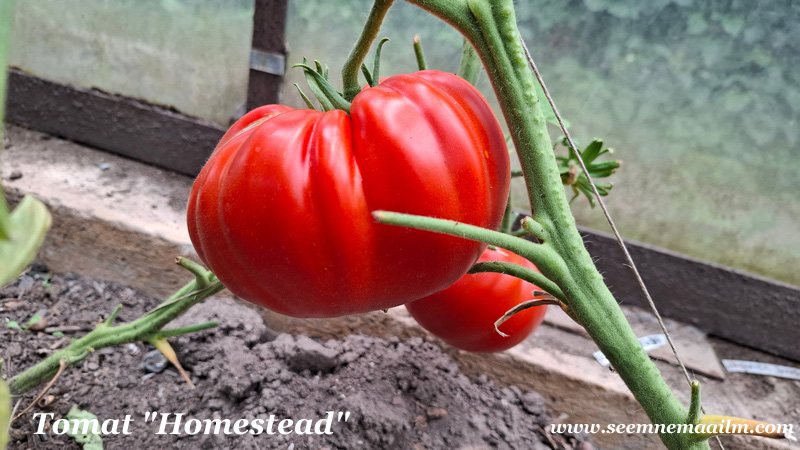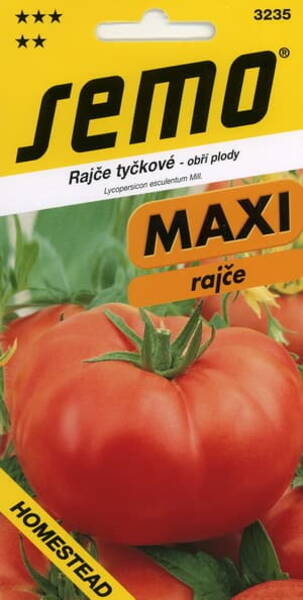Ex Tax: 2.45€
Late-ripening variety with large and fleshy fruits (up to 500 g).

How to prolong fruiting?
At the end of summer, most thermophilic garden crops, even when grown in greenhouses, begin to "lose ground" (nights become cool, and days are shorter, so the plants experience stress, as a result of which the growth and filling of fruits stop). To prevent this from happening, such cultures need to be helped.
In tomatoes, the period from setting to the beginning of reddening of the fruit is approximately 60 days (30 days the fruits grow, and then another 20-25 ripen). This means that if the autumn turns out to be warm, then the entire ovary formed on the bushes has a chance to ripen or at least reach the milky stage of ripeness, at which it is possible to harvest the crop without lowering its marketability.
At the end of August, all old leaves and overgrown stepchildren are removed from tomatoes and, if this has not been done earlier, pinch the tops. Brushes that have already matured and are just beginning to bloom are subject to removal. Even if they tie the fruits, they will not have time to grow them to the required size, but only in vain will take strength from the bushes. 2-3 leaves are left above the brushes that already have ovaries to ensure their nutrition.
If in the summer the greenhouse must be constantly ventilated, regularly arranging a draft, then in the fall, in order not to let in cold and humid air, the doors and vents are tightly closed. They are open only during the day and then for several hours in sunny weather, when there is no rain and it is warm outside. As a result of such actions, the greenhouse will be hot, like in the south, and the tomatoes will ripen quickly.
In order not to provoke fungal infections, the watering of tomatoes is stopped, and the mulching layer between the bushes is renewed. This is necessary not only to retain moisture but also to protect plants from diseases that develop in the upper layers of the soil. The worst enemy of tomatoes, late blight, also suspends its development in such conditions.
At the end of summer, tomatoes are most in need of potash fertilizers - they help both quick filling and improve the taste of the fruit. Before feeding the bushes, all brown fruits are removed from them, after which they are sprayed with solutions of potassium sulfate or monophosphate (1-1.5 g per 1 litre of water). You can replace them with an ash extract, in which, in addition to phosphorus and potassium, all trace elements are present. A glass of ash is poured with 2 litres of hot water, let it brew overnight, then filter the infusion, bring the volume of water to 10 litres and spray the bushes over the leaves.
After such procedures, finding themselves on a "meagre ration", tomatoes redirect all their strength only to the filling of already existing fruits.
Tomatoes ripened on the bush contain more sugars, dry matter and vitamins. If the weather and conditions in the greenhouse permit - do not rush to harvest, because ripened tomatoes are always sour.
In addition, the tomato fruits, having begun to acquire a characteristic colour for the variety, no longer grow, therefore they do not take any food from the bush. On the contrary, they begin to secrete ethylene, which promotes the ripening of other fruits.
Do you know such a recipe?
Take medium-sized tomatoes, cut off the top and carefully, with a teaspoon, take out the core with the seeds, without disturbing the integrity of the fruit.
Salt prepared tomatoes, sprinkle with pepper and fill with minced meat and rice.
Put the fruits filled with minced meat in a greased pan, sprinkle with grated cheese, sprinkle the tomatoes with oil and bake in the oven.
Ready fruits can be poured with sour cream and sprinkled with chopped parsley or dill.
Tomatoes of any variety are suitable for this recipe, but large-fruited tomatoes are ideal.












